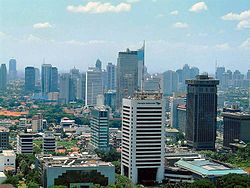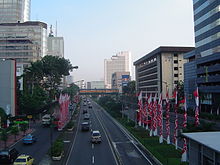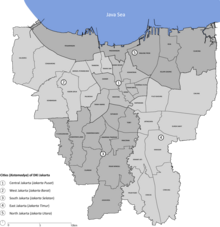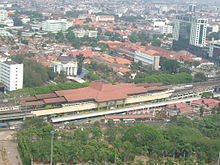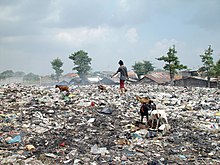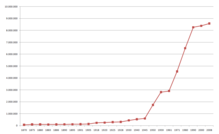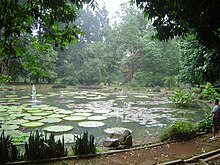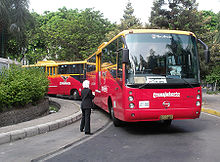Jakarta
| Jakarta | |||
|---|---|---|---|
|
|
|||
| Coordinates | 6 ° 11 ′ S , 106 ° 50 ′ E | ||
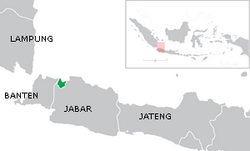
|
|||
| Symbols | |||
|
|||
| Basic data | |||
| Country | Indonesia | ||
|
Geographical unit |
Java | ||
| Capital District | Jakarta | ||
| ISO 3166-2 | ID-JK | ||
| height | 8 m | ||
| surface | 661.5 km² | ||
| Metropolitan area | 7315 km² | ||
| Residents | 10,042,000 (2010) | ||
| Metropolitan area | 34,365,000 (2019) | ||
| density | 15,180.2 Ew. / km² | ||
| Metropolitan area | 4,697.9 Ew. / km² | ||
| founding | 1527 | ||
| Post Code | 10110-14540, 19110-19130 | ||
| Telephone code | 021 | ||
| Website | www.jakarta.go.id | ||
| Others | |||
| governor | Anies Baswedan (since 2017) | ||
| City structure | 5 boroughs | ||
| License Plate | B. | ||
|
Jakarta skyline
|
|||
Jakarta / dʒa- / (up to the Indonesian spelling reform of 1972 Djakarta written) is the capital of the Republic of Indonesia . With 10.04 million inhabitants (2018) in the city proper, it is the largest city in Southeast Asia and with around 34 million inhabitants (2019) in the metropolitan region of Jabodetabek, it is the second largest metropolitan area in the world. The capital has the status of a province and is ruled by a governor. The city is officially listed under Daerah Khusus Ibu Kota Jakarta (Special Capital Region Jakarta).
Jakarta is the country's political, economic and cultural center as well as a transport hub with universities, colleges, theaters and museums. The city's population is of diverse origins; people of Malay , Arab , Indian , Dutch and Chinese descent live in it .
geography
location
The city is located in Jakarta Bay ( Indonesian Teluk Jakarta ) on the northwest coast of Java Island at the mouth of the Ciliwung , an average of eight meters above sea level . The urban area is flat and has an area of 661.52 km². The area is used for agriculture, tropical rainforest can be found in favorable places.
The Kepulauan Seribu (German: "Thousand Islands") group of islands is located in Jakarta Bay . The 105 islands, 45 km north of the city, have an area of 11.8 km². The local marine national park serves to relax the population.
The metropolitan region of Jabodetabek has an area of 7315 km² and includes the capital Jakarta, the cities of Bekasi , Bogor , Depok and Tangerang as well as the administrative districts of Bekasi , Bogor and Tangerang .
geology
The geological structure of the island of Java, on which Jakarta is located, is mainly determined by volcanic material. Only a small part of the area consists of older rocks, more than two thirds are covered by volcanic deposits: ash, tuff and lava from recent and older eruptions. The remaining part consists of tertiary sediments .
The island lies at the point of the Sunda Arc , where the shattering of the earth's crust was most intense, the old subsoil was most destroyed and today the Java Sea is largely sunk below sea level. Numerous volcanoes are still active today. Their ashes are blown far across the land and form a constantly effective mineral fertilizer. There is either direct ash fall, or the volcanic loose masses are transported through the rivers and deposited.
Currently the Dutch colony of Jakarta was far above sea level, but since then significantly decreased . Today sea water has to be pumped out of the city. The “National Capital and Integrated Coastal Development Master Plan” was developed to save Jakarta from sinking. It is also considered to build a new capital on the island of Borneo.
City structure
Officially, Jakarta does not have the status of a city, but of a province with the special status of the capital of Indonesia. Therefore, instead of a mayor, there is also a governor.
Jakarta Province is divided into five administrative units (Kota Administrasi) : North Jakarta (Jakarta Utara) , East Jakarta (Jakarta Timur) , South Jakarta (Jakarta Selatan) , West Jakarta (Jakarta Barat) and Central Jakarta (Jakarta Pusat) , each headed by a mayor and a government district ( Kabupaten ) for the Kepulauan Seribu archipelago in the Bay of Jakarta with a regent ( Bupati ) as a guide.
The cities are divided into districts ( Kecamatan ) , municipalities ( Kelurahan ) , residential areas (Rukun Warga) and neighborhoods (Rukun Tetangga) .
Northern Jakarta
North Jakarta is located directly on the Java Sea and is divided into 6979.4 km² sea area and 154.11 km² land area over a length of 35 km. Many people work in the Tanjung Priok port and other industrial settlements. North Jakarta borders the Java Sea in the north, Bekasi in the east, east, west and central Jakarta in the south and Tangerang in the west . The six subdistricts of Northern Jakarta are Cilincing, Kelapa Gading, Koja, Pademangan, Penjaringan and Tanjung Priok.
East Jakarta
With 187.73 km², East Jakarta has the largest land area of the five districts. It is divided into 95% land, the rest is covered with swamp or rice fields at a height of 50 meters above sea level . Since the establishment of five business parks, East Jakarta has grown in economic importance.
East Jakarta is bordered by North Jakarta to the north, Bekasi to the east, Depok to the south and South and Central Jakarta to the west. The ten sub-districts of East Jakarta are Cakung, Cipayung, Ciracas, Duren Sawit, Jatinegara , Kramat Jati, Makasar, Pasar Rebo, Matraman and Pulo Gadung.
South Jakarta
South Jakarta has an area of 145.73 km². South Jakarta is bordered by Central Jakarta in the north, East Jakarta in the east, Depok in the south, West Jakarta in the northwest and Tangerang in the west. The district is divided into ten subdistricts - Cilandak, Jagakarsa, Kebayoran Baru, Kebayoran Lama, Mampang Prapatan, Pancoran, Pasar Minggu, Pesanggrahan, Setiabudi and Tebet - with a total of 65 communities.
West Jakarta
The land area of West Jakarta is 127.11 km². The district borders in the north on North Jakarta, in the east on Central Jakarta, in the south on South Jakarta and in the west on Tangerang. West Jakarta is divided into eight sub-districts: Cengkareng, Grogol Petamburan, Kalideres, Kebon Jeruk, Kembangan, Palmerah, Taman Sari and Tambora - with a total of 56 parishes.
Central Jakarta
Central Jakarta is the smallest of the five districts. It has a land area of 48.17 km², has a flat topography and borders on all four other parts of the city. It is subdivided into eight sub-districts - Cempaka Putih, Gambir, Johar Baru, Kemayoran, Menteng, Sawah Besar, Senen and Tanah Abang - with a total of 44 communities, which in turn are divided into 388 residential areas with 4,784 neighborhoods.
climate
The city is located in the tropical climate zone . The annual average temperature is 26.2 ° C, the annual rainfall 1,799 millimeters on average.
The average maximum daily temperatures in Jakarta are between 28.9 and 31.1 ° C. The daily average temperatures are all year round between 25.6 and 26.7 ° C, with the highest temperature in October at 26.7 ° C and the lowest in February at 25.6 ° C in the long-term average.
The main rainy season is between December and March. Most of the precipitation falls in January and February with an average of 300 millimeters, the least in September with an average of 29 millimeters. Jakarta is mostly hazy due to high rainfall and air pollution.
Heavy rains repeatedly cause flooding in Jakarta during the monsoons . At the beginning of February 2007 three quarters of the megacity were under water, hundreds of thousands of people became homeless, and 80 deaths were counted. The flood surpassed the flood disaster of 2002, in which 21 people died and more than 300,000 were left homeless. Catastrophic floods also occurred in 2013 and 2020.
| Jakarta | ||||||||||||||||||||||||||||||||||||||||||||||||
|---|---|---|---|---|---|---|---|---|---|---|---|---|---|---|---|---|---|---|---|---|---|---|---|---|---|---|---|---|---|---|---|---|---|---|---|---|---|---|---|---|---|---|---|---|---|---|---|---|
| Climate diagram | ||||||||||||||||||||||||||||||||||||||||||||||||
| ||||||||||||||||||||||||||||||||||||||||||||||||
|
Average monthly temperatures and rainfall for Jakarta
Source:
|
||||||||||||||||||||||||||||||||||||||||||||||||||||||||||||||||||||||||||||||||||||||||||||||||||||||||||||||||||||||||||||||||||||||||||||||||||||||||||||||||||||||||||||||||||||||||||||||||||||||||||||||||||
history
First settlement and kingdom of Pajajaran
The area of what is now Jakarta has been part of the Hindu kingdom of Pajajaran since the end of the 12th century , which was able to maintain its independence from the Hindu kingdom of Majapahit, which ruled large parts of the Malay Peninsula , Sumatra and Borneo , and became an excellently organized one had developed a prosperous state through the pepper trade. The capital Pakuwan was located near today's Bogor , 60 kilometers south of Jakarta.
At the end of the 15th century, the main port of the Pajajaran Empire, called Sunda Kelapa , was built at the mouth of the Ciliwung . The Portuguese landed there in 1522 and, with the consent of the ruler, built a fort to protect the port for the spice trade. The Muslim prince Fatahillah from the Kingdom of Demak had the city destroyed by his troops on June 22, 1527 and built a new city on the same site, which was named Jayakarta (German: Jayakarta, alluding to the double victory over the armed forces of the Portuguese and the Kingdom of Pajajaran) : Great Victory).
Dutch colonial times
Towards the end of the 16th century, more and more Dutch merchant ships docked there. In 1613 the Dutch East India Company (VOC) established the first trading post in front of the city, which was expanded into a fort in the following years. On May 30, 1619 Jayakarta was captured and burned by troops led by Governor General Jan Pieterszoon Coen (1587-1629). Coen founded the city of Batavia on its ruins , which became the seat of the VOC in Asia and the capital of the Dutch East Indies colony .
The eruption of the Salak volcano on January 5, 1699, combined with a vertical and horizontal earthquake , destroyed many buildings in the city. The natural event triggered large earth movements in the Javanese coastal region, which changed the course of the Ciliwung River, on which Batavia lay. The city's canals filled with mud, which worsened the sanitary situation of the population.
Over time, Batavia attracted more and more enterprising Chinese , who settled here as bankers, merchants, designers and shipbuilders, many of whom became prosperous. This came to an abrupt end with the Batavia massacre in 1740, when ten thousand Chinese were killed by the Javanese with the assistance of the Dutch colonial army.
From Batavia, the Netherlands controlled all of Java, parts of Sumatra and the Spice Islands ( Moluccas ) at the beginning of the 18th century . However, diseases and epidemics also spread in the rapidly growing tropical port city. A fellow traveler on the circumnavigation of the British navigator James Cook (1728–1779) describes the Dutch Batavia in 1770:
“There are few streets in this city through which a fairly wide canal has not been led; and besides these it is cut by five or six rivers. The streets are consistently wide and the houses large; for both reasons this place has, in proportion to the number of buildings, a larger size than any other city in Europe. ... The canals, which for the most part contain stagnant, very polluted and putrid water, give off an intolerable stench in the hot season, and the many trees prevent the free flow of air, whereby those harmful fumes could still be dispersed to some extent.
In the wet season ... the water in these unclean channels swells so much that it emerges from its banks and floods the lower floors in the low areas of the city. Once it has expired, you will find an unbelievable amount of mud and excrement where it was. ... Out of a hundred soldiers dragged here from Europe, we were assured that by the end of the first year there were hardly fifty alive ... In all of Batavia we did not find a single person who looked quite fresh and healthy. "
The residents who could afford it settled further south outside the city walls, where the new Batavia was built. In 1778 the Royal Batavian Society of Arts and Sciences was founded in Jakarta.
After the bankruptcy of the East India Company in late December 1799, the Dutch state took over the entire colony.
A British attack on August 28, 1811 on the fortified position of Meester Cornelis , today in the sub-district of Jatinegara , the Dutch could not withstand. During the brief British rule until 1816, the researcher Sir Thomas Stamford Raffles (1781-1826) carried out a series of progressive reforms, founded the Botanical Garden in Bogor and researched the history of the country.
In the course of the 19th century, the Netherlands consolidated their economic and political power over the archipelago from Batavia . For climatic reasons, the European inhabitants increasingly lived in the up-and-coming suburb of Weltevreden , which was planned according to the European model and also received a city theater in 1821, today's Gedung Kesenian Jakarta . With the opening of the Suez Canal on November 16, 1869, the transport routes were shortened; the volume of trade increased and more and more Europeans came to Batavia. In 1876 a new port was built in Tanjung Priok. In 1880 Batavia had 100,000 inhabitants, by 1915 this number had doubled.
In 1926 the Communist Party of Indonesia (PKI) called for a revolutionary war of liberation. The uprising failed because of the superior Dutch colonial power. A year later, the Partai Nasional Indonesia, founded by Achmed Sukarno (1901-1970) after the PKI was broken up, took up the fight against the Dutch.
During the Second World War , the armed forces of the Japanese Empire began their attack on Indonesia in December 1941. They occupied Batavia on March 5, 1942 and forced the Dutch to surrender on March 8 . On August 8, 1942, Batavia was renamed Jakarta. The more than three hundred years of their colonial rule was over. Most of Jakarta's residents welcomed the Japanese as liberators from the yoke of the Europeans. However, the enthusiasm quickly evaporated when the Asian superpower established a regime of terror and arbitrariness. Japanese rule ended with their surrender on August 15, 1945.
independence
The later President Sukarno proclaimed the national philosophy “ Pancasila ” in Jakarta in 1945 and, together with Mohammad Hatta (1902–1980), declared Indonesia's independence on August 17, 1945 . The city became the capital in 1950, the first year of the independent Republic of Indonesia.
At the end of the 1940s the city exceeded the population of one million, 15 years later it was already 4.5 million. Slums spread, and at the same time, despite economic problems, President Sukarno had colossal monuments, magnificent boulevards and prestige buildings built. Suharto , who came to power in 1967 , largely continued this policy.
From May 12-14, 1998, Jakarta and the rest of the country experienced the worst unrest since the alleged communist attempted coup in 1965, which plunged the country into chaos and anarchy . Members of the Kopassus special unit kidnapped and killed several supporters of the democracy movement in the city, triggering the unrest. Tens of thousands of people marched through the streets looting, setting fire to houses and cars, and numerous Chinese women were raped. The “Volunteers Team for Humanity” documented 152 rapes and sexual assaults, 20 of the victims died. According to the official State Commission for Human Rights Komnas HAM, the unrest in Jakarta resulted in 1,188 lives and 101 injured. Only a small part of the victims belonged to the Chinese minority. Most of the dead were looters trapped in the burning buildings. On May 21, 1998, Suharto resigned as president of the country.
In the following years there were several bomb attacks in the Indonesian capital. A bomb explosion in front of the residence of the Philippine ambassador on August 1, 2000 left two dead and 23 injured, including the diplomat. On September 13, 2000, a car bomb detonated in an underground car park at the Jakarta Stock Exchange and set off a fire. 15 people were killed and 27 injured. The police assume that the perpetrators come from the Suharto area and that the attack was aimed at disrupting the corruption process against the former president. Since the World Bank office was located in the building , international terrorism cannot be ruled out either.
A bomb attack on the JW Marriott Hotel on August 5, 2003 killed twelve people. There were about 150 injured. The police suspect a suicide bomber from the Islamist group Jemaah Islamiyah was behind the attack. Several suspects were arrested just days later. A year later, on September 9, 2004, the Australian embassy was the scene of a terrorist attack in which a total of 11 people lost their lives, including the suicide bomber, and 168 people were injured. Here too, according to various sources, the Jemaah Islamiyah group was responsible.
Relocation of the capital
In the summer of 2019, the Indonesian government announced that it would move the capital to the province of East Kalimantan on the island of Borneo in 2024 . The as yet unnamed new capital is to be built on previously forested state-owned areas of the administrative districts of Penajam Paser Utara and Kutai Kartanegara near the cities of Balikpapan and Samarinda . One reason for the installation is the subsidence of the floor by up to 25 cm per year in places.
Population development
Jakarta's population has grown from around 600,000 in 1945 to 9.6 million in 2010. This dramatic increase in population has resulted in overpopulation , unemployment , crime , increased traffic and high levels of pollution in parts of the city . A population of 15.9 million is expected by 2050.
In order to prevent a further increase in the number of inhabitants, those responsible for the city administration issued an immigration restriction in 1970, according to which only people with a job are allowed to move to Jakarta. Due to the narrow city limits, the population increase has meanwhile been significantly weakened; this is mainly taking place in the countless suburbs, which now have 18.4 million inhabitants. In 2010, a total of 28.0 million people lived in the Jakarta metropolitan area .
City planners assume that by 2016 a new giant city of Jabodetabek with 32 million people will have been built. Jabodetabek is composed of the first letters of the cities Jakarta, Bogor , Depok , Tangerang and Bekasi , which will then roughly form the boundaries of the new metropolis.
Half of the population growth is due to the immigration of rural residents, who seem to have greater chances of getting a job, training or a little wealth here than at home. The great attraction of the capital region attracts young people in particular to break out of the monotonous everyday life of a Javanese village. The success is rather modest. Many live in the slums on the outskirts of the city. Monotonous new development areas are still rare. Instead, hundreds of thousands of small cheap houses were built, which fit into the traditional "Kampung", village-like districts of Jakartas.
People of all origins live in Jakarta. However, the majority of the population are Sundanese and Javanese . There is also a larger Chinese minority in Jakarta. The population of Jakarta is made up as follows: Javanese (2.9 million), Betawi (2.3 million), Sundanese (1.2 million), as well as minorities of Arabs, Indians, Europeans (Dutch) and Chinese.
The following overview shows the number of inhabitants according to the respective territorial status of the city. Up to 1959 these are mostly estimates, from 1961 to 2010 they are census results.
|
|
politics
City government
Anies Rasyid Baswedan has been governor of the capital district DKI (Daerah Khusus Ibukota) Jakarta since October 16, 2017 . The following governors (mayor until 1960) have ruled Jakarta so far:
|
|
Town twinning
Jakarta has partnerships with the following cities:
|
Regional partnerships
Jakarta has partnerships with the following regions:
-
 Tokyo Prefecture ( Japan ) since October 23, 1989
Tokyo Prefecture ( Japan ) since October 23, 1989 -
 New South Wales ( Australia ) since May 30, 1994
New South Wales ( Australia ) since May 30, 1994
Culture and sights
religion
86 percent of Jakarta's residents are Muslim . Practically all of them belong to the Sunni school . There are only a few hundred Shiites in Jakarta . Many residents practice a syncretic form of Islam. Followers of this form call themselves Abangan .
Ten percent of the residents are Christians : 6.5 percent belong to the Protestant Church and 3.5 percent to the Roman Catholic Church. The Christian Church in Jakarta is young, as Christianity did not gain a foothold until the 17th century (through Dutch and Portuguese missionaries). The former governor, Basuki Tjahaja Purnama, is a Christian.
Another 4 percent of the population are Hindus or Buddhists (the latter mostly belonging to the Chinese minority).
Music, dance and theater
The traditional culture typical of Jakarta developed among the Betawis , a now homogeneous ethnic group of former traders and workers who immigrated from Europe, China, India and other countries in Southeast Asia during the colonial period. The forms of cultural expression that emerged from the 18th century onwards differ from the pribumi culture of the long -established Javanese and Sundanese people. The performing Betawi art, which is cultivated in the suburbs on the occasion of seasonal public festivals and private celebrations as well as occasionally at cultural events in the city center, includes the music genre Gambang Kromong , which is also used to accompany the Ciokek dance style and the Lenong operetta . The Tanjidor - marching music clearly shows their European origin.
The only theater and event building (Gedung Kesenian) that has survived from the Dutch colonial period dates from 1821 and is still used today as a theater for concerts and ballet performances. It is not far from Independence Square (Merdekaplatz) in a north-easterly direction.
In the Ria Loka , the cabaret Srimulat is performed with comical scenes and songs. Ketoprak, Javanese folk theater, musically accompanied by gamelan , which draws its themes from folk legends and fairy tales, is offered in the Bharata Theater , not far from Pasar Senen. Wayang Orang performances (= Wayang Wong) based on the Ramayana or Mahabharata also take place on this stage . Wayang Wong and Ketoprak are also performed monthly in Taman Mini, Ancol Dreamland and Gedung Kesenian .
Museums

Around the old town hall square (Taman Fatahillah) several colonial buildings have been restored with the support of UNESCO . The focus is on the Jakarta Museum , which is housed in one of the oldest preserved buildings. Built in 1710, it served as the “Stadthuys” (town hall) of the administration, later it became the military headquarters and, until the Second World War, the seat of the administration of West Java. A historical museum has been housed there since 1974. It houses a collection of weapons, furniture, old maps and other relics from the colonial era.
The "Wayang Museum" is located on the west side of the square. The traditional puppet theater is common all over Southeast Asia. Stick puppets and shadow puppets as well as the associated instruments and other items that are needed for a performance are exhibited there.
The "Museum of Art and Painting & Museum of Ceramics" (Balai Seni Rupa) houses a collection of Indonesian paintings and ceramics. In the building of the former Palace of Justice on the east side of the square, built in 1870, you can find pictures by well-known Indonesian painters. The ceramics department is also interesting. On the north side of the square opposite the town hall stands the old Portuguese cannon "Si Jagur", a symbol of fertility.
West of Independence Square is the National Museum (Museum Pusat) or Gedung Gajah (Elephant Building), so called because of standing there, by the Thai King Chulalongkorn (1853-1910) presented in 1871 as a gift Bronze - elephants . It is one of the largest and best-equipped museums in Southeast Asia. It was founded by the Dutch as early as 1868. The collection provides detailed information about the volcanoes and islands, peoples and their customs, traditional arts and crafts on all the islands of the archipelago .
The National Museum houses an impressive collection of Hindu works of art from Java as well as porcelain from the Han , Tang and Ming periods . In the prehistoric department, the remains of the Java man (= Homo erectus ), numerous cult objects, stone inscriptions and Hindu and Buddhist statues are exhibited. In the ceramics department you can see around 2000 year old pottery and porcelain, mostly from China.
Buildings
Buildings on the Great Canal
It is not far from the Town Hall Square to the “Great Canal” (Kali Besar). There are numerous trading offices, commercial buildings and warehouses from the colonial era. The two houses on the western side of the canal, the corner house of the “Chartered Bank” and the “Toko Merah” house, date from the beginning of the 18th century, today: PT. Dharma Niaga. There are also two buildings that were erected by German emigrants, the houses "Imhoff" and "Wurmb".
The house of the Governor General Gustav Wilhelm von Imhoff (1705–1750) from Leer in East Friesland , who came from Germany, is an elongated red brick building called "Toko Merah". It is currently used as an office building, but can be visited. The large hall with the double stairs is well worth seeing. The original furniture is partly placed in the town hall. Imhoff's tombstone is shown in the “Wayang Museum”, which was built at “Taman Fatahillah” in place of the dilapidated old church.
The house of Baron Friedrich von Wurmb (1742–1781) from Thuringia , to whom Friedrich Schiller (1759–1805) dedicated his short story “A Magnanimous Action”, is two buildings away from the “Imhoff House”. There are two lion sculptures in front of the entrance. A generous entrance hall in need of renovation, built in the classicism style, gives an idea of the former splendor. Friedrich von Wurmb was one of the founders of the Batavian Society for Art and Science. Its collections form the basis of today's National Museum and the National Library.
In a northerly direction there is the restored last over 200 year old drawbridge "Hoenderpasarbrug" (Hühnermarktbrücke). At the mouth of the canal is the observation tower, which was only built in 1839, from which the harbor master saw the incoming ships. It is built on the walls of the fortification "Bastion Culemborg" from 1645.
Independence Square
At the beginning of the 19th century, most of the administrative buildings had been relocated from the contaminated old town to the new Batavia around the Koningsplein. Today, Independence Square (Merdeka Square), which is around one square kilometer in size, is clearly dominated by the 132 meter high showpiece of Sukarno's monumental art , the national monument ( Monas ) with its flame, which is coated with 35 kilograms of gold . The viewing platform is 115 meters high.
The east side of the square is dominated by the two-story “ Gambir station ”, which was renovated in 1993 . Opposite is the "Emmanuel Church", a round domed building with an entrance gate that could have come from a Doric temple. In 1839 the "Willemskerk" named after King Willem I (1772–1843) was opened as the first joint church by Lutherans and Reformed people .
Behind the bridge, on the Pejambon, stands the Independence Building (Gedung Pancasila), which was built around 1830 as the residence of the military commander in the classicism style. Since 1918 the "Volksraad" resided there, the members of which came predominantly from the white colonial population and had little political power. In 1945 a committee set up by the Japanese (BPUPKI, later PPKI) under the leadership of Sukarno worked out the new constitution. On June 1, 1945, Sukarno explained the Pancasila state philosophy from the building .
To the northeast is the Ministry of Finance, construction of which began in 1809 under Herman Daendels, Governor General from 1807 to 1811. He wanted to reorganize the corrupted colonial system with a firm hand and renew the old contaminated Batavia. The war with Great Britain and his transfer ended these activities. North of the Ministry is the Supreme Court (Mahkamah Agung), which has been meeting in this neoclassical building since 1848.
To the west is the Catholic Cathedral , built in 1900 in neo-Gothic style with some Indonesian influences. The 77-meter-high towers were built from teak, because the former cathedral from 1833 collapsed in 1880 under the weight of the towers.
The Istiqlal Mosque made of white marble and German steel offers space for 120,000 worshipers. The huge, modern dome building is located between Medan Merdeka and Lapangan Banteng. The mosque , designed by the Catholic architect Silaban, was completed in 1961 under Sukarno . With this structure Jakarta has the second largest mosque in the world after Istanbul ( Sultan Ahmet Mosque ).
Further to the west is the Presidential Palace ( Istana Merdeka ). The building had been the official residence of the Dutch governor since 1879, who however preferred the cool climate of Buitenzorg ( Bogor ).
Chinatown
South of the Kota or Hauptbahnhof , in Jl. Pangeran Jayakarta 1 is the oldest church in the city, "Gereja Sion", built between 1693 and 1695. The so-called "Portuguese Church outside the city walls" was used by the descendants of the first Portuguese conquerors, their native allies and slaves who had been captured by the Dutch in India and Malaya and taken there. Beautiful baroque carvings adorn the altar, the organ and the pews. A plaque in Dutch commemorates the opening of the church on October 19, 1695.
Further to the south is the old Chinese quarter "Glodok". The typical Chinese atmosphere with the shops, restaurants and workshops open to the street is increasingly being lost due to numerous monotonous new buildings such as modern shopping centers, banks and blocks of flats in the uniform concrete style. Much was also destroyed there during the unrest in 1998.
In the Jl. Petak Sembilan is the most important Chinese temple in the city, "Jin De Yuan" (also called Kim Tek I or Wihara Bhakti), which was built in 1650 by the Chinese lieutenant Guo Xun Guan in honor of the goddess of mercy. The roof of the main temple is decorated with Naga snakes and other porcelain figures, while Buddhist and Taoist figures are inside . The figure of the "ruler of the three worlds" (San Yuan) above the main entrance dates from the 17th century. The Chinese community gathers in the temple on Chinese holidays, for example the "Festival of Hungry Ghosts" or the Chinese New Year.
Other structures
At the end of the Jl. Pantai Sanur is one of the oldest Chinese temples, the "Ba Do Gong Miao" (Klenteng Ancol). It was probably built on the orders of the Chinese eunuch Admiral Zheng He and Admiral Wang Zhu Cheng, who visited the archipelago seven times from 1405 to 1430 with their fleet on behalf of the Ming Emperor Zhu Di (1360-1424). Zheng He is venerated as the Holy Sampo Kong in a temple in Semarang (Central Java). In the main building of Klenteng Ancol are the statues of the two admirals. There are several old graves behind the main building.
The villa of the well-known Javanese painter Raden Saleh (1811–1880) is located near the “Cikini” train station. He spent four years of his life in Dresden from 1839 and was a welcome guest at the castles of Duke Ernst II of Saxe-Coburg and Gotha (1818-1893) until 1852 . After returning to Java, he had his residence built in memory of Callenberg Castle near Coburg . Today it is used as the administration building of the Cikini Hospital and is open to the public.
In the Jl. Hayam Wuruk next to the Bali Bank, there is a mosque from 1786, the "Mesjid Kebon Jeruk". It was built by the Muslim-Chinese Chan Tsin Whu. After the pogrom of 1740, many Chinese tried to escape persecution by converting to Islam . These Orang Cina Peranakan had to break away from Chinese society and at times even had their own leaders (Kapten). The mosque complex has ornate tombs, including the tomb of Atimah Whu, wife of the builder. The tombstones are decorated in both Chinese and Arabic styles.
The cornerstone of the Jakarta Tower was laid on April 16, 2004 . The 558 meter high tower should be completed in 2009 and at that time replace the CN Tower in Toronto as the highest television and radio transmission tower . The Jakarta Tower will no longer achieve this title because its completion is still uncertain and because the Tokyo Skytree with a height of 634 meters was inaugurated in May 2012 .
Also noteworthy is the 395 meter high Jakarta Indosiar transmission mast .
Near Jakarta is the world's largest still existing port for cargo sailing ships, Sunda Kelapa. These cargo sailing ships travel the entire Malay island world and the South China Sea.
Parks
"Taman Impian Jaya Ancol" is Southeast Asia's largest amusement park with an area of 137 hectares, with an art market, open-air theater, swimming pool, bowling alley, golf course and an aquarium . Ancol is also home to the fantasy world “Dunia Fantasi”, which opened in 1985, an Indonesian mixture of Disneyland and fairground in the architectural style of different epochs and continents.
The marina is located further towards the beach . From this marina boats go to Kepulauan Seribu, the archipelago of the "Thousand Islands" in Jakarta Bay. The 105 islands, 45 kilometers north of Jakarta, have an area of 11.8 square kilometers. In the local marine national park there are various restaurants, hotels, bungalow complexes and a boat rental shop on the lagoon . In the Dolphinarium shows are with sea lions, daily dolphin shown and other animals.
In the approximately 100 hectare “ Taman Mini Indonesia Indah ” theme park in the south-east of the city, the Republic of Indonesia was recreated in miniature, with all provinces of the country represented by scale buildings in traditional architectural styles and handicrafts. In addition to the most modern museums for energy, natural history and technology, there are also ethnological museums such as the Museum Indonesia . A multi-vision show “Indonesia” is to be viewed; a modern theater was inaugurated in 1997.
The Botanical Garden in Bogor , the Kebun Raya near Jakarta, is the seat of many international research institutes. It was founded on May 18, 1817 by Caspar Georg Carl Reinwardt (1773-1854) from Lüttringhausen and today contains a collection of over 3,000 types of plants, including over 200 types of palm and 883 types of orchids . The titan arum ( Amorphophallus titanum ), an arum plant with an inflorescence over two meters high, is famous . The botanical garden is a popular and worthwhile excursion destination in a quiet and pleasant environment.
Culinary specialties
Both national and international cuisine can be found in the restaurants of the Indonesian capital. The many local dishes include rice soup (soto, sop), various noodle dishes and sate , chicken skewers grilled over a small portable grid, which are eaten with peanut sauce . Also tasty are krupuk , crackers baked in oil made from tapioca flour and ground crab or fish, tahu and tempeh goreng, fried cubes made from soybean quark or pressed soybeans . Local specialties are also the stuffed duck Bebek “Betutu” and the lightly marinated fried fish “Ikan Acar Kuning”. The fish dishes steamed in a banana leaf (Pepes Ikan) are another local specialty. Tahu and tempeh (a kind of soy meatball) are often cooked with spinach or celery.
The fried rice ( Nasi Goreng ) and the fried noodles (Mie Goreng) are spicy . On the other hand, the peanut sauce is sweetly prepared for the various grilled sate meat skewers. They get a particularly delicate aroma when the skewers are made of lemongrass. With “Gado Gado”, the sweetened peanut sauce is poured over the vegetable salad in a warm form.
In addition to the stationary restaurants, you can also find street vendors ( Kaki Lima = "five feet" = standard width of the sidewalk) who offer soups with small meatballs or other of the aforementioned specialties and prepare them freshly on site.
In addition to these local specialties, you can of course also find all other types of restaurants, especially the western fast-food restaurant chains.
trade
Jakarta has numerous markets as well as many large department stores and shopping malls. The larger markets in the city include the fish market "Kali Baru" and the "Bird's Market" (Pasar Burung) south of Jl. Pramuka, at the beginning of the city highway. At the "Pasar Seni Ancol", a large arts and crafts market in the Ancol amusement park, arts and crafts such as carvings, pictures, plaiting and weaving work are produced and sold. An art exhibition is located in the adjoining two-story building.
The shopping centers Grand Indonesia, Plaza Indonesia, das Fx, Plaza Senayan, Hayam Wuruk, Gajah Mada Plaza, Pasar Senen and Ratu Plaza in Jl. Jen. Sudirman and Blok M in Kebayoran Baru. The largest shopping centers are Pondok Indah Mall (PIM) in the south, Kelapa Gading and Mangga Dua in the north, and Taman Anggrek in the east of the city. There are now supermarkets that also meet European standards in all parts of Jakarta.
Economy and Infrastructure
According to a study from 2014, the Jakarta metropolitan area has a gross domestic product of 321 billion US dollars (KKB). In the ranking of the economically strongest metropolitan regions worldwide, it took 30th place.
Economy and environment
The most important sectors of Jakarta's economy are the food and beverage industry, textile and leather industry and tobacco processing. Labor-intensive, export-oriented industries such as textile, toy and shoe manufacture are becoming increasingly important.
Typical of these sectors are the purely private, often multinational companies, while in the cement and fertilizer industries, petrochemicals and metallurgy, state-owned companies or joint ventures with state participation predominate. An opening away from the often unprofitable state-owned companies and towards more deregulation and privatization is emerging.
Jakarta is also the country's banking center. The Indonesia Stock Exchange as well as the largest banks ( Bank Bukopin , Bank Central Asia , Bank Internasional Indonesia , Bank Mandiri and Bank Rakyat Indonesia ) are based here.
Overall, Jakarta's economic development has been positive since 1967. Despite all the negative phenomena such as urban poverty, unemployment, inadequate infrastructure and environmental pollution , it has been possible to raise the standard of living of the population. From 1997 to 2000 Jakarta's economy was severely affected by the domestic and global economic crisis. Factory closings were the order of the day, unemployment rose enormously and export earnings fell sharply. The gross domestic product (GDP) has only risen again since 2001 .
In the industry, which is concentrated in the Jakarta metropolitan area, there are only inadequate disposal and cleaning capacities for sewage, exhaust gas and waste. In addition to infectious diseases such as cholera , diarrhea and typhoid , which are spread due to inadequate hygienic conditions, there are respiratory and skin diseases due to the toxic emissions from numerous industrial plants and car traffic. Particular problems arise from the often direct neighborhood of poorer residential areas and industry. The population cannot be adequately supplied with clean drinking water. The untreated industrial wastewater of the capital directly affects 500,000 people and indirectly around 5 million people in the mouth of the Citarum River . The water and soil are contaminated with very high levels of lead, cadmium, chromium and pesticides, so that the Blacksmith Institute included the river in its 2013 list of the “Top 10 Most Polluted Places in the World”. Since then, the Indonesian government has been trying to remedy the situation with the help of loans from the Asian Development Bank.
In a ranking of cities based on their quality of life, Jakarta was ranked 142nd out of 231 cities worldwide in 2018.
traffic
Long-distance transport
Jakarta is an important traffic junction with air and rail lines, ports, highways and overland bus terminals. At the international airport Soekarno-Hatta in Cengkareng, 23 kilometers west of Jakarta, all international and national flights are handled. It can be reached from the center of Jakarta via an expressway.
The regional rail network in the Jakarta metropolitan area ( Jabodetabek region - Jakarta, Bogor, Tangeran and Bekasi) consists of several lines with a total length of around 125 kilometers. The sections of the route used by local and long-distance trains are partially electrified.
The trains are often severely overstaffed during rush hour when the required vehicle capacity cannot be compensated by the operator due to failures. Tragic accidents are not uncommon. From Kota- or Gambir Station in Jakarta there are train services to Central and East Java.
Jakarta has several seaports, including the old port called Kelapa Sunda , which is also interesting for tourists , where wooden freighters from the entire archipelago handle their goods, and the modern port of Tanjung Priok , where the Pelni ships have passenger and RoRo connections to the most important sea ports in Indonesia. There is also a larger fishing port west of Kelapa Sunda.
Local transport
The roads in Jakarta are in poor condition. Apart from the regional railway network of KAI Commuter Jabodetabek , a subsidiary of the state-owned Indonesian Railway , there was no high-performance, high-capacity rail-bound transport system in the city that could relieve the roads.
A 24 km long subway line has been under construction since the end of 2013 , the first section of which went into operation on March 24, 2019. Another metro line with a completion horizon between 2024 and 2027 is in the planning stage.
Local public transport is largely handled by diesel-powered buses that share the lanes with private transport.
At the end of 2004, the TransJakarta was also introduced as a separate bus system with previously seven central lines. For this “Metrobus” system, one lane was structurally separated (except in intersection areas); in addition, fixed stopping stations were set up. The air-conditioned buses are designed in such a way that it is only possible to get on and off at the designated stops. The entrances are a good one meter high.
The heavy traffic on the streets with cars and mopeds results in daily traffic jams, which not only make it difficult to move around and lead to increased air pollution from exhaust gases, but also exacerbate other problems: For this reason alone, garbage cannot be disposed of efficiently in the capital, because the garbage trucks are stuck in traffic most of the time.
The smaller buses let their passengers get on and off at the edges of the lane or in the middle of the lane.
In the past Jakarta had a tram network that went back to a horse-drawn tram from 1869 and whose operation was discontinued in 1962. Steam trams operated from 1881 and electrification took place from 1899.
Another way to get around is to use the numerous taxis available .
There are no sidewalks or they are in very poor condition. Pedestrian crossings are as good as nonexistent. The existing pedestrian bridges are popular meeting places for beggars, small traders and pickpockets.
media
The Indonesian capital is the headquarters of the ANTARA news agency . It was founded on December 13, 1937. In 1962, ANTARA became the official news agency of Indonesia. Jakarta is also the seat of the English-language daily newspaper The Jakarta Post , which first appeared on April 25, 1983.
Important daily newspapers in the Indonesian language (Bahasa Indonesia) are the Jakarta-based “Hidayatulla”, “Jawa Pos”, “Kompas”, “Media Indonesia”, “Republika” and “Suara Pembaruan”. The news magazine "Tempo" is published in English, Indonesian and Japanese. Important business newspapers are "Bisnis Indonesia", "Kontan" and "Surat Kabar". The latter appears in English and Indonesian. The largest sports newspaper in the capital is "Bola". It is published in the Indonesian language.
education
Jakarta is the seat of the following universities: Universitas Indonesia , Universitas Negeri Jakarta, Universitas Trisakti , Universitas Atma Jaya , Universitas Pancasila, Universitas Bina Nusantara, Universitas Kristen Krida Wacana, Universitas Tarumanagara, Universitas 17 Agustus, Universitas Bung Karno, Universitas Mercu Buana, Universitas Gunadarma , Universitas Pelita Harapan, Universitas Jayabaya, Universitas Pembangunan Nasional, President University, Universitas Muhammadiyah , Universitas Indonusa Esa Unggul, Universitas Mercu Buana, Universitas Yarsi, Universitas Kristen Indonesia and Indonesia Banking School .
Universitas Indonesia is a state university. It opened on February 2, 1950. In the 2005/2006 semester , 11,011 students from numerous countries were enrolled . The university is divided into the following twelve faculties : Faculty of Medicine (FK), Faculty of Dentistry (FKG), Faculty of Mathematics and Natural Sciences (FMIPA), Faculty of Law (FH), Faculty of Psychology (FPsi), Faculty of Engineering (FT), Faculty of Economics (FE), Faculty of Public Health (FKM), Faculty of Social and Political Sciences (FISIP), Faculty of Humanities (FIB), Faculty of Computer Science (Fasilkom) and Faculty of Nursing (FIK) .
Personalities
literature
- Fauzi Bowo: Basics and guidelines for the development of the Jakarta metropolitan area. Indonesia. University of Kaiserslautern, dissertation in the field of architecture / spatial and environmental planning / civil engineering. 1999.
- Bernd Brunnengräber: Urban traffic in Jakarta: An investigation of actors and decision-making conditions , Verlag für Entwicklungspolitik, Saarbrücken, 2001, ISBN 3-88156-749-6
- Martin Heintel , Heinz Nissel, Christof Parnreiter, Günter Spreitzhofer, Karl Husa (editor), Helmut Wohlschlägl (ed.): Megacities of the Third World in the Globalization Process. Mexico City, Jakarta, Bombay - Comparative case studies in selected cultures . University of Vienna, 2000, ISBN 3-900830-40-1
- Jacqueline Knörr: Creole and Postcolonial Society. Integration and Differentiation in Jakarta. Campus Verlag, Frankfurt am Main & New York 2007, ISBN 978-3-593-38344-6
- Marion Markham: Courtesy and hierarchy among the Javanese living in Jakarta . Peter-Lang-Verlag, Frankfurt am Main, 1995, ISBN 3-631-47744-9
- Bodo Schulze: Non-State Actors and Territorial Control. On the production of (in) security in Jakarta (PDF) University of Hamburg, Research Center for Wars, Armaments and Development, 2009.
- Günter Spreitzhofer, Martin Heintel: Metro-Jakarta: Between Nasi and Nike . Peter Lang, European Science Publishing House, 2000, ISBN 3-631-35992-6
Web links
- Austrian Embassy Jakarta
- German Embassy Jakarta
- German International School Jakarta
- Goethe Institute Jakarta
- Super jam in Jakarta, from: zenith - magazine for the Orient
Individual evidence
- ↑ Summary of the 2010 census ( Memento of December 3, 2013 in the Internet Archive ) (PDF; 16.7 MB)
- ↑ a b demographia.com (PDF)
- ↑ Indonesia: Country Data and Statistics. Retrieved March 10, 2019 .
- ↑ Jakarta is sinking: A city is digging itself up from the water. In: www.deutschlandfunk.de. October 12, 2019, accessed November 9, 2019 .
- ↑ Verena Kern: Land under. In: Klimareporter. November 2, 2019, accessed November 4, 2019 .
- ↑ 2007 Global Register of Major Flood Events. In: dartmouth.edu . Retrieved January 3, 2020.
- ^ Floods in Indonesia - Chaos and risk of epidemics in Jakarta. ( Memento from September 20, 2008 in the Internet Archive ) Tagesschau from February 5, 2007.
- ↑ Niniek Karmini: Rescuers find more bodies in Jakarta floodwaters. In: smh.com.au . January 3, 2020, accessed on January 3, 2020.
- ↑ Temperatures based on averages from 1994–1999, Meteorological and Geophysical Agency, Indonesia
- ↑ M. Müller, 1983: Handbook of selected climate stations of the earth. University of Trier, stadtklima.de
- ↑ wetterkontor.de , Jakarta climate table
- ↑ Amrita Moehring-Sen: The comparison of two cities under the rule of the VOC in the 16th and 17th centuries: Batavia and Malacca. GRIN Verlag, Munich 2007, p. 8, ISBN 3-638-83160-4
- ↑ Thomas Schleich, Thomas Beck: Europe and the non-European world. Writings of the University Library Bamberg, Bamberg 1988, Vol. 6, p. 31, ISBN 3-7661-4565-7
- ↑ Indonesia Old City: History of Jakarta city name ( Memento from January 20, 2012 in the Internet Archive )
- ^ Society for Threatened Peoples: The Chinese Minority in Indonesia - Scapegoat for Corruption and Mismanagement ( Memento of the original of September 27, 2007 in the Internet Archive ) Info: The archive link was automatically inserted and not yet checked. Please check the original and archive link according to the instructions and then remove this notice. , November 1998 memorandum
- ↑ Hamburger Abendblatt : Chronicle of the attacks in Indonesia since 1999 , from October 1, 2005
- ^ Jokowi: Indonesia's new capital will be in East Kalimantan. Borneo Post, August 26, 2019
- ↑ Lena Bodewein: Indonesia: The capital Jakarta is sinking. NDRInfo, September 27, 2019
- ↑ City population 2050 | Sustainability Today. Retrieved July 25, 2018 .
- ↑ International Development Research Center: Participatory planning process in Dakar and Jakarta: two great stories! ( Page no longer available , search in web archives ) Info: The link was automatically marked as defective. Please check the link according to the instructions and then remove this notice. (PDF; 32 kB)
- ↑ a b c d e f g h i j k Perayaan HUT Jakarta Berharga RP 3.5 billion. Retrieved August 2, 2012 (Indonesian).
- ↑ Walikota Berlin Bangga Dengan Kota Jakarta. (No longer available online.) Archived from the original on April 19, 2014 ; Retrieved August 2, 2012 (Indonesian). Info: The archive link was inserted automatically and has not yet been checked. Please check the original and archive link according to the instructions and then remove this notice.
- ^ Twin city Jakarta. (No longer available online.) Archived from the original on October 14, 2012 ; Retrieved August 2, 2012 . Info: The archive link was inserted automatically and has not yet been checked. Please check the original and archive link according to the instructions and then remove this notice.
- ↑ Gubernur DKI dan Walikota Hanoi Tandatangani MOU Sister City. Retrieved August 2, 2012 (Indonesian).
- ↑ Islamabad-Jakarta Sister City Agreement to be reactivated. (No longer available online.) Archived from the original on January 19, 2012 ; accessed on August 2, 2012 . Info: The archive link was inserted automatically and has not yet been checked. Please check the original and archive link according to the instructions and then remove this notice.
- ^ Sister Cities of Istanbul. Retrieved August 2, 2012 .
- ^ Sister Cities of Los Angeles - Jakarta, Indonesia. Retrieved August 2, 2012 .
- ↑ Les pactes d'amitié et de coopération. Retrieved August 2, 2012 (French).
- ↑ Beijing's Sister Cities. Retrieved August 2, 2012 .
- ↑ Kerja Sama Sister City Jakarta-Pyongyang Ditandatangani. (No longer available online.) February 28, 2007, archived from the original on September 23, 2015 ; Retrieved August 2, 2012 (Indonesian). Info: The archive link was inserted automatically and has not yet been checked. Please check the original and archive link according to the instructions and then remove this notice.
- ^ Jakarta-Rotterdam Cooperate on Flood Handling. (No longer available online.) Archived from the original on September 23, 2015 ; accessed on August 2, 2012 . Info: The archive link was inserted automatically and has not yet been checked. Please check the original and archive link according to the instructions and then remove this notice.
- ^ Seoul-Jakarta Cooperation Getting Stronger. Retrieved August 2, 2012 .
- ^ Sister Cities. Archived from the original on July 18, 2014 ; accessed on August 2, 2012 .
- ^ Indonesian capital gets a Christian governour. Article in the Daily Mail. Retrieved May 23, 2016.
- ^ Alan Berube, Jesus Leal Trujillo, Tao Ran, and Joseph Parilla: Global Metro Monitor . In: Brookings . January 22, 2015 ( brookings.edu [accessed July 19, 2018]).
- ↑ H. Angga Indraswara: woes Water. Private sector participation in Jakarta's water supply has left many citizens high and dry. Inside Indonesia, January 95 - March 2009
- ↑ Top Ten Threats 2013 (PDF) from the Blacksmith Institute
- ↑ Mercer's 2018 Quality of Living Rankings. Retrieved July 30, 2018 .
- ^ Website of the KAI Commuter Jabodetabek. Retrieved January 22, 2017 (Indonesian).
- ↑ Roland Rohde: Indonesia's capital region receives a modern road and rail network. In: www.gtai.de. Germany Trade and Invest , January 31, 2017, accessed on February 1, 2017 .
- ↑ Michael Lenz: First subway in Jakarta: An answer to the megastau . In: The daily newspaper: taz . April 3, 2019, ISSN 0931-9085 ( taz.de [accessed on May 10, 2020]).
- ↑ TransJakarta Busway ( Memento from September 1, 2008 in the Internet Archive )



